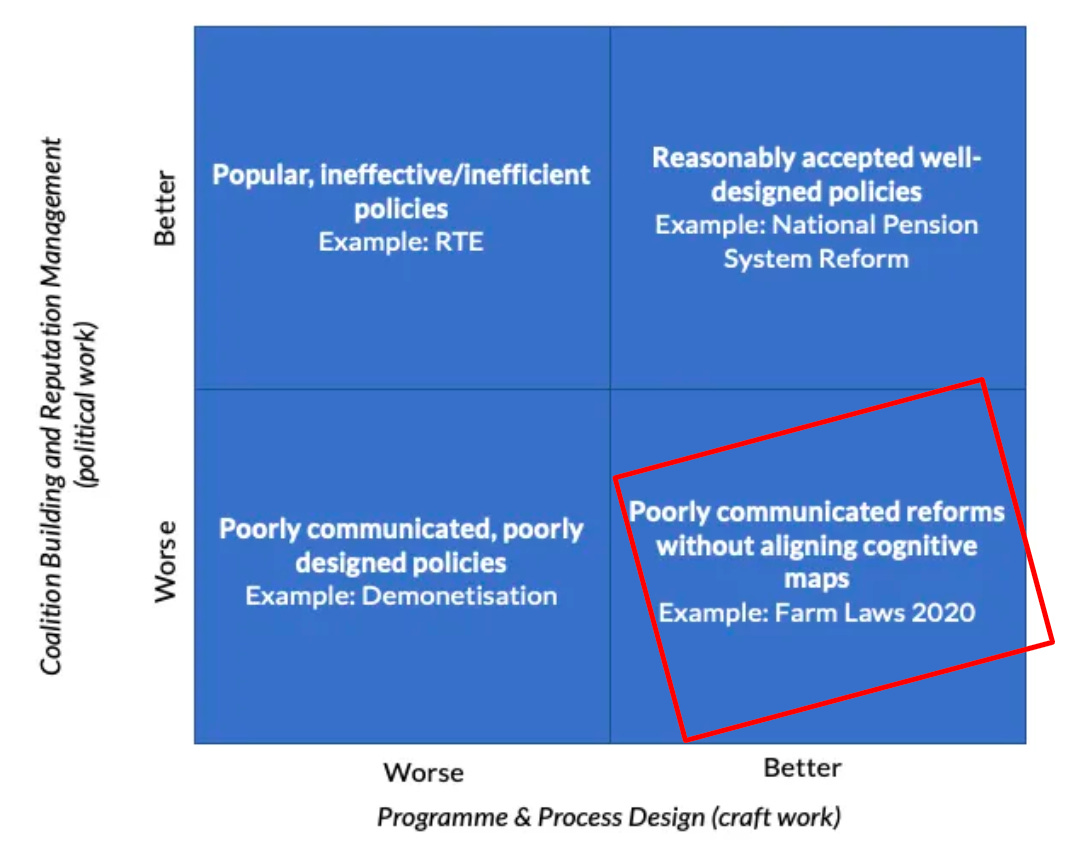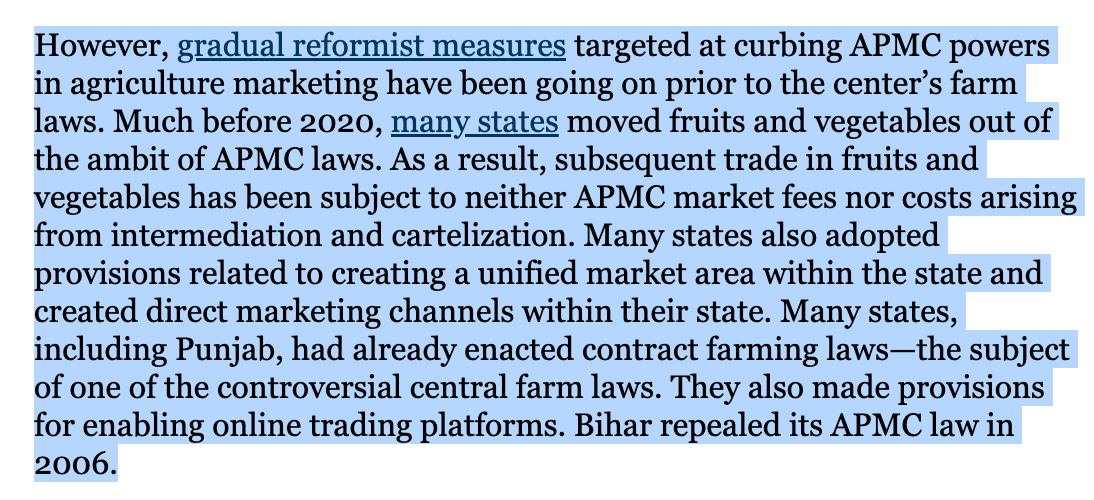Saturday Sprouting Reads (Digital Agronomy, Farm Laws, Corteva's 'Bioquisition', Alternative Protein Funding, Production Hubs in Agriculture)

Dear Friends,
Greetings from Hyderabad, India! Welcome to Saturday Sprouting Reads!
About Sprouting Reads
If you've ever grown food in your kitchen garden like me, you would realize the importance of letting seeds germinate sooner than later. As much as I would like to include sprouting as an essential process for the raw foods that my body loves to experiment with, I am keen to see how this mindful practice could be adapted to the food that my mind consumes.
You see, comprehension is as much biological as digestion is.
And so, once in a while, I want to look at a bunch of articles or reports closely and chew over them. I may or may not have a long-form narrative take on it, but I want to meditate slowly on them so that those among you who are deeply thinking about agriculture could ruminate on them as slowly as wise cows do. Who knows? Perhaps, you may end up seeing them differently.
Programming Announcement:
As I’ve mentioned before in one of my dialogue videos, my grandstanding vision for Agribusiness Matters that is pulsatingly alive is this:
“Agribusiness Matters will be the preferred meditation retreat for Agritech Executives, Founders and Investors across the world to pause, introspect, flex their thinking muscles and ponder over the hard, wicked problems they encounter in their everyday working lives.”
I envision Agribusiness Matters to be a place, a vibrant community where founders, executives and investors can slow down, see the forests for the trees and honestly ask themselves: In doing what I am doing, what am I really doing?
Agribusiness Matters Private Slack Community Invite went out to members yesterday. Like everything else in the world right now in the midst of a climate emergency (We had the hottest February in India in the last 146 years), this is an experiment to build a decentralized, self-organizing community. If you are a member and haven’t received the invite yet, let me know.
[Subscriber-Only]: Blast from the Past: Why the War Against Spurious Inputs will Never Be Won
BATMAN: Then why do you want to kill me?
The Joker starts laughing. After a moment he's laughing so hard it sounds like sobbing.
JOKER: Kill you? I don't wanna kill you. What would I do without you?.....No? No. No! No, you- you complete me.
Just as sleek-looking tax filing websites need complicated income tax forms to exist,
Just as private security forces in Afghanistan need the Taliban to orchestrate attacks on NATO caravans to create demand for their services,
Successful agri-input brands need their counterfeit counterparts to create demand for authentic agri-inputs and prove their successful market share and brand presence.
Applied Microeconomics 101 for Agri-Input Supply Chain: Demand for Authentic Agri-Inputs increases when the prices of its complements - spurious and substandard agri-inputs - decreases.
It’s counter-intuitive, no doubt.
But it makes sense if you meditate deeply on how systems work by defining strict boundaries which manage their interactions with the environment outside, which in turn define the very structure the system is made of.
[Subscriber-Only] Making Sense of Bharat Krushi Seva
In a fledgling domain like agritech, just when you start to think that aggregators are hindering the evolution of technology, Ashby’s Law of Variety reminds you of the fundamental power of variety to propel technological systems forward.
In an ideal world, Bharat Agri must have evolved to become what Bharat Krushi Seva is now, as I explore its set of capabilities in the app installed on my phone. That both started their journey from the Indian city of Pune is perhaps a coincidence:) Or maybe not.
When I sketched the Digital Agronomy Quadrant for Indian Agritech in 2021, I had placed Bharat Agri in the low-touch, Paid Quadrant. Today, I would include Bharat Krushi Seva in the same quadrant.
Last year, Bharat Agri was charging 1199 INR for a year of personalized agronomy advice. Few days ago, I got a call from Bharat Krushi Seva asking me to join their annual package to receive personalized agronomy advice at 299 INR.
Can personalized agronomy services challenge agency problems rampant in smallholding contexts?
It’s 2023. The Repeal of Farm Laws Now Doesn’t Matter

I’ve been tracking Farm Laws since their inception and have looked at their ramifications for Indian Agriculture closely.
My analysis of Farm Laws and farmer protests so far:
Part-1: Setting the Context 🔒 | Part-2: No Country for Middle-Men | Part-3: In Defense of the Government 🔒 | Part-4: Samudra Manthan in the World of Agriculture: | Part-5: "Annadata" Conundrum" And Mapping the Cultural Wars of Agriculture 🔒 | Part-6: Can I offer you a grey pill on farm laws? | Part -7: Greta Thunberg and the aftermath of Farm Law Politics in India | My TEDx Talk on the need to dialogue in context with the farm laws.
It’s a sweet irony, I suppose, to now examine an argument that puts forth an argument that the reformist trajectory hasn’t reversed with the repeal of the farm laws.
In this May 2022 article, Anirudh Burman places a powerful argument that the reformist trajectory is well in progress, despite the political compulsions. Perhaps, we can give Indian Agriculture the due credit for its decentralized design that made this possible.
In hindsight, when I wrote Part-2 of my Farm Laws Analysis in October 2020, I had predicted this:
“Now, when you try to centralize the state subject of agriculture, naturally there is going to be resistance from the States.
28/ As soon as the Centre created new market areas where farmers could sell their produce without being subject to state regulations and fees, Rajasthan, by an act of legal abracadabra, redesignated all those new areas also as state-controlled markets. ‘
29/ The Central Govt.’s response is yet to be seen. You can very well expect other non-BJP states to respond like Rajasthan did, based on how the laws relating to agricultural markets have been framed in the respective states.”
Anirudh makes an insightful point here that the steady reformist trajectory of agricultural markets has been in progress much before the farm laws.

Of course, if you think in first principles, agricultural reform is an infinite game and based on changes in marketing laws, it would be too premature to conclude that everything is hunky dory, especially if you are in touch with how many illegible transactions are happening in the ground.
For starters, if we are serious about reform, we have to tax agricultural income in India. There will be a lot of political pressure. I hope we get there soon.
Corteva Completes Acquisition of Symborg and Stoller Group
That the Goliathan Agrochemical Industry has been going through an existential crisis in its audacious pursuit to “feed the world” sustainably without further messing up with soil organic matter in an era of climate emergency is widely known.
The Davids working hard to earn the trust of farmers, helping the Goliaths change their stripes and dance to the changing tunes of customer expectations aren’t widely known.
And so naturally my eyes perked up when I saw Corteva announcing their completion of the acquisition of Symborg and Stoller Group
“The biologicals market is expected to be the fastest-growing crop protection segment in the industry, representing 25% of the overall market by 2035.”
Currently, there are two types of Davids working in the biological space. The first type is those who claim how much microorganism extracts they have in their kitty.
The second type is those who are quietly building microbial discovery platforms at scale. If I am concerned about short-term profitability, I would bet on the first type. If I am concerned about the infinite game, I would bet the latter.
Alternative Proteins Funding - Downs and Ups
Michal Klar writes a good overview of the alternative protein funding landscape and where it is currently. There were two powerful takeaways from this:
→ “For the first time, most alt protein investments went to non-American startups.”
This largely aligns with my earlier subscriber-only analysis of Buhler Group when I looked at their alternative protein plans in detail and how they want to engage with agritech startups. Perhaps, they are seeing the same trend and focusing their efforts on the growing APAC protein scene.
→ Investors are largely betting on plant-based over cultivated alternative technologies.
“Plant-based startups got $1.2 billion, -41% year-on-year
Cultivated (cell-based) = $896 million, -33% YoY
Fermentation (biomass and precision) = $842 million, -50% YoY”
In the case of India, as I wrote earlier for subscribers, we are facing an interesting conundrum: India has a massive protein deficiency crisis and has the best livestock model in the world.
Production hubs in Agriculture: Case Study
At an elemental level, the concept of production hubs is as old as mountains. However, if you want to bring together agritech and climate funding climate in action together in 2023, production hubs are worth the attempt to change the old wine bottle.
Based on the work of Sustain Plus Energy Foundation (SPEF) (set up by CInI, Social Alpha and Selco Foundation), a new case study has been released that extols the importance of designing production hubs.
Here is how the paper defines Production Hubs:
“A production hub may be defined as a contiguous cluster of villages where actors in and around it enable an ecosystem for continuity of farm production (agriculture and livestock) and associated marketing. A production hub can be catered to by a combination of processes to ensure production of high-value crops and market access for farmers of crops and livestock.”
At least 100-150 small farmers with an aggregate of 25+ acres of crop command
A support system (mostly irrigation) which supports year-round farming (June to March)
A minimum of eight to ten metric tons of weekly production to increase farmer and trader interface to 100 to 120 days of the year at the farm gate. The idea is to enable a minimum critical production volume that encourages/attracts traders to procure from the hub
The results, although defined limitedly in terms of activities and solutions are interesting:
“Activities enabled by SPEF straddle across the value chain. e pre-production stage of the value chain has led to improved irrigation and productivity enhancement. SPEF has implemented approximately 125 hydroponic systems and 120 polyhouse (greenhouse) sheds. In the production stage of the value chain for productivity enhancement, SPEF has implemented 123 livestock-related solutions and solar egg incubators. In the post-production stage of the value chain, it has implemented approximately 125 post-harvest solutions for processing (e.g., millets processing, rice huller, spice grinder, apricot/spices/herbs dryer, mustard oil extractor) and 43 solutions for packaging and storage (e.g., cold storage) in geographies across India”
Instead of activities, can we measure the success of production hubs based on private gross capital formation metrics?
I hope we would then have a better view of the impact of these activities.
So, what do you think?
How happy are you with today’s edition? I would love to get your candid feedback. Your feedback will be anonymous. Two questions. 1 Minute. Thanks.🙏
💗 If you like “Agribusiness Matters”, please click on Like at the bottom and share it with your friend.








